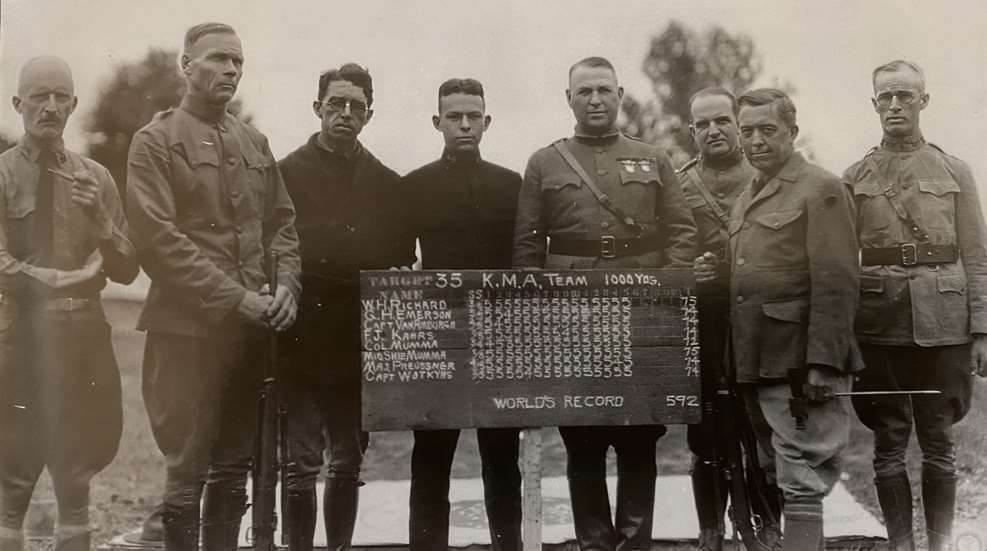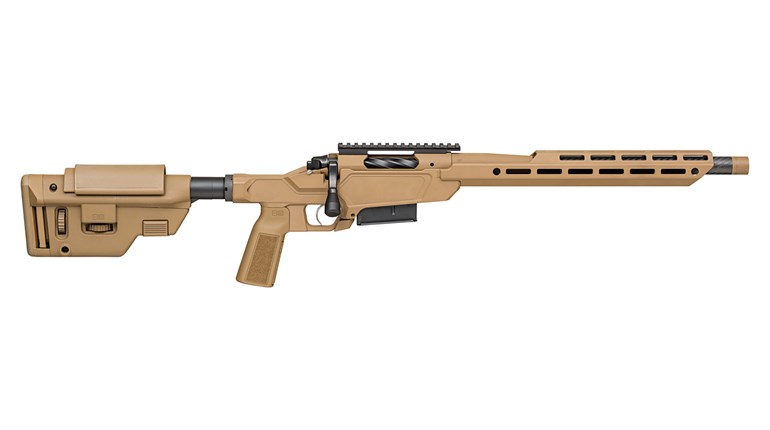
Beginning in 1921, the workmen at Springfield Armory assembled, for each year’s National Matches, a quantity of Model 1903 rifles specially constructed of selected parts and hand fitted to provide competitive shooters with the best “Service Rifles” available. Receivers, bolts, triggers, cocking pieces and sights were selected for dimensional precision and hand fitted for smoothness of operation. Barrels were selected from among the most dimensionally perfect available and were fitted to receivers by the best men in the shop. Care was taken to ensure that the extractor collar rotated smoothly. Cocking and extracting cams were hand honed to remove sticky spots. Sights were adjusted to provide smooth adjustment for windage. Triggers were set to provide the crispest pulls possible. From 1921 until the beginning of World War II, the National Match Springfield was the standard against which other bolt-action rifles were measured. But the National Match Springfield wasn’t the only game in town.
In 1922, Winchester got into the act—with a rifle that attested to the excellence of Springfield Armory’s work. Winchester couldn’t beat Springfield, so they joined it. Winchester built target rifles using Model 1903 Springfield actions.
Winchester supplied the barrels for these rifles—26-inches long, tapering from 1⅛-inch diameter at the breech to ⅞ inch at the muzzle, made from nickel steel. Winchester also seems to have done the stocking—in two styles. Style (“Type” according to Winchester) No. 1 used a modification of the then-newly adopted Model 1922 Springfield target rifle stock: a half-length fore-end held in place by a band that also held the sling swivel, and a European-style, rounded full pistol grip, similar in appearance to that used on contemporary Mauser military rifles. Illustrations of the Type No. 1 appear as though the buttplate is of Model 1903 service style. The Type No. 1 came with telescopic sight bases on the barrel and no metallic sights.
Type No. 2 rifles were fancier. Barrels were of the same dimensions as the Type No. 1, but fitted with what appears to be the front sight from a Springfield Model 1921 “free rifle.” A Lyman No. 48 aperture rear sight was fitted. Type No. 2 stocks had more of a sporting flair. The fore-end had a schnabel tip. The front band was inside the stock and the front sling swivel attached to it through a clearance hole in the wood. Type No. 2 stocks were also full pistol gripped, but with a grip cap rather than the rounded grip found on the Type No. 1. The Type No. 2 stock also had a cheekpiece and was fitted with a recoil pad. Type No. 2 rifles had checkered pistol grips.
Stephen Trask, then a noted and authoritative writer on small arms and a frequent contributor to shooting and outdoor publications of the time, published a description of Winchester’s efforts in Arms and the Man (a predecessor of American Rifleman) for August 1922. Reading between Trask’s lines one learns that the rifles were follow-on models to wartime efforts to develop a suitable sniper rifle and that the Springfield Armory built a prototype as well. From Trask’s description, what became known as the Type No. 1 was to have been an issue piece. The Type No. 2 was to be built on special order, using a Winchester barrel and stock and the customer’s Model 1903 action.
The Winchester Sniper rifle was successful. At the National Matches in 1922, Capt. Guy Emerson of the Ohio National Guard used a Winchester Type No. 2 Sniper rifle, fitted with a Winchester A-5 telescopic sight, to win the Wimbledon Cup. It was Emerson’s third victory in the prestigious match. He shot the rifle again that year as a member of the scratch team put together by Army Lt. Col. Morton Mumma and entered in the Herrick Trophy Match under the name “Kernal Mumma’s Amateurs.” Mumma assembled the team—which included himself, Emerson, Frank Kahrs of Remington, W. H. “Cap” Richard of Winchester, Army Captains Don Preussner (later Major), Charles Van Amburgh, and Grosvenor Wotkyns and Midshipman M.C. Mumma, Jr. (later Rear Admiral, USN)—despite the entry rule that required Herrick teams to be made up of members of a state association or military activity. Though billed as such, the team’s 1,000-yard score was not a record (at 592 of 600 points possible, it was a very fine score, perhaps the best 1,000-yard stage score posted that year), nor did they win the match. Victory in the Herrick for 1922 went to the Massachusetts National Guard with a record-setting aggregate of 1775 for the 1800-point, three-stage course. The “Amateurs” are remembered chiefly for their skill and pluck, their reputations as superb marksmen and for the abbreviation of their name—the “K.M.A. Team.” (It was the second time a team had been assembled using those initials.) They can be remembered, as well, for the fact that the team used Winchester Sniper rifles.
Winchester did not spend a lot of time and effort popularizing the sniper rifle. Instead, they went to work to develop what became the Model 54 bolt-action rifle introduced in 1925. How many sniper rifles were made is hard to say. It certainly wasn’t many. The K.M.A. team for example, shared two of the rifles, Emerson’s and one apparently furnished by Richard. (Interestingly, and to balance Richard’s influence, Kahrs supplied the ammunition. Both Winchester and Remington got considerable advertising mileage out of the team’s performance.) When the late Lt. Col. William S. Brophy published his definitive book, The Springfield 1903 Rifles (Stackpole Books, Harrisburg, Pa., 1985), he knew of only three specimens in existence—one Type No. I rifle and two Type 2s—and theorized that they were the only ones made.


































